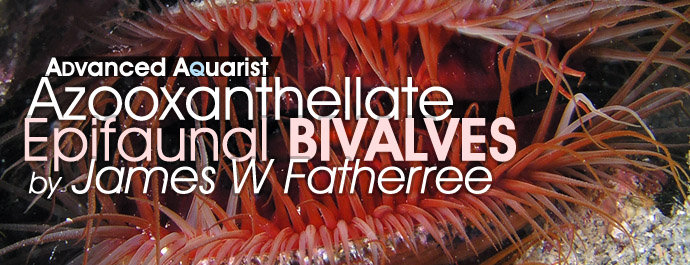
Most reef aquarium keepers know something about the commonly-offered tridacnids, otherwise known as the giant clams. But, there are a few non-tridacnid clams that are also available to us, some that hitchhike into our aquariums on live rock and such, and some that just show up seemingly from nowhere from time to time, too. These include a variety of scallops and oysters, and a few other species, none of which are well-suited for aquarium life primarily due to their demanding dietary needs. So, I want to provide you with some general information about the biology of clams and some specific information about why they can be difficult to keep alive long-term in aquariums. I’ll also give you some information about a few types of clam that are commonly seen in reef environments and sometimes for sale.
To start, all clams are bivalves. Each half of a clam’s shell is properly called a valve, and the “bi” part is obviously added to it because there are two of them. Like coral skeletons, these valves are composed of calcium carbonate, and are produced by the living tissues of the clam. However, clams are about as distantly related to corals as an animal can be. While corals are members of the Phylum Cnidaria and are relatively simple animals, clams belong to the Phylum Mollusca. This phylum is also home to the snails, cephalopods, and a several other invertebrates that are far more complex than the corals and their kin.
Some of these molluscs swim around all the time while some crawl about. Some of them, such as the infaunal clams, live their lives buried in the substrate, too. However, I’ll be sticking to the epifaunal clams, which are the ones that live on the bottom rather than in it, or attach themselves to rocks, macroalgae, or other invertebrates, such as corals, etc. And with that said, I want to get back to complexities for a moment.
Clams don’t appear to be very complicated animals while just sitting around on the bottom of the sea or an aquarium. However, they actually have a full set of well-developed specialized organs. They have complex gills, a mouth, stomach, and intestines, a heart, kidneys, ovaries and/or testes, a well-developed (albeit brainless) nervous system, and more. Many of them even have eyes. So, they’re far more complicated than they might seem.

Oddly enough, several types of clam have eyes. For example, giant clams may have thousands of very simple lens-less, cup-like eyes covering their fleshy surfaces, as seen on the left.1,2 Many scallops and spiny oysters have surprisingly complex eyes though, which have a lens and two layers of retinal cells, as seen in the other two photos.3
This isn’t just trivial information, though. Once you realize that a clam is actually a lot more complex than they appear to be on the outside, it shouldn’t be too hard to understand why they have a much higher caloric demand than a much simpler animal like a coral. Clams have a lot going on inside their shells, and it takes a surprising amount of food to keep all of their biological machinery running.
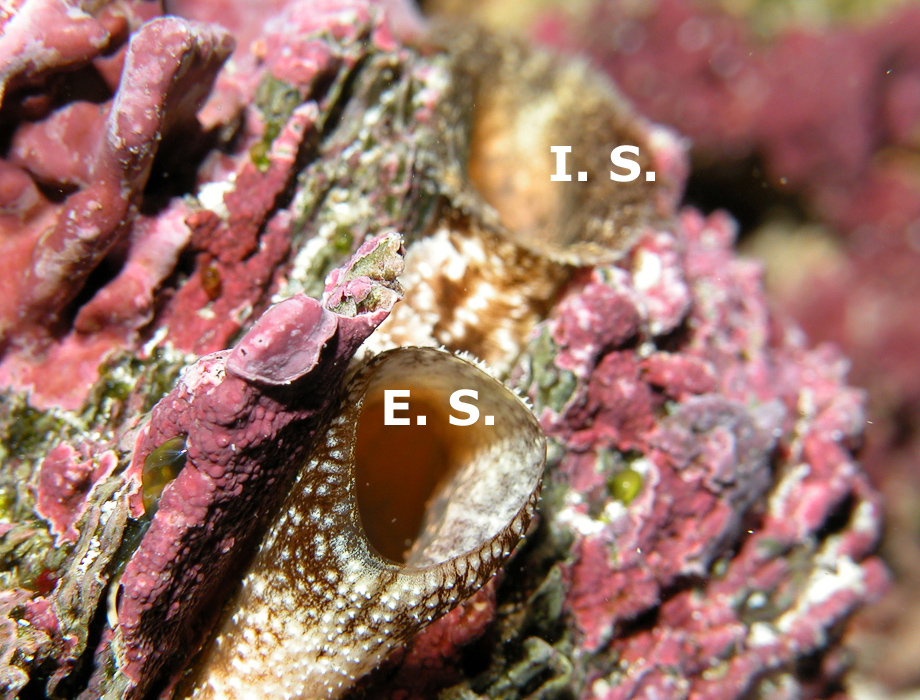
Here you can see a jewel box clam (Chama macerophylla), a species often found on aquacultured live rock from Florida. This one has opened its valves a bit and has extended its tube-like siphons, which are the openings where water is moved into the clam and over its gills, and then back out minus any captured food particles. Water is taken in through the inhalent siphon in the background and leaves through the exhalent siphon in the foreground.
To cover their nutritional needs, the vast majority of clams strain various sorts of plankton from the surrounding waters, making them filter-feeders by definition. Their gills are finely branched structures that take in oxygen and give off carbon dioxide, but they’re responsible for the capture of food particles, too. They’re covered by numerous, microscopic hair-like structures called cilia, which can move back and forth rhythmically to create a current of water that flows over the gills for gas exchange. And, by creating such currents, they also draw in food particles along with the water. As these waterborne particles pass over the gills, many of them stick to their surfaces and are then moved along by cilia into grooves that ultimately direct the particles to a clam’s mouth. Various types of particles are also sorted out to some degree along the way to the mouth, and most of the indigestible/unsuitable stuff is discarded. As far as the digestible material goes, many clams can actually use a variety of phytoplankton, zooplankton, and bacteria, but can also make use of some detritus, too. However, for the most part they rely on phytoplankton, specifically.4,5,6,7,8,9
Tridacnid clams are a bit different than the rest though, as they can cover their nutritional needs in more than one way. While they can and often do filter-feed, they also contain large complements of live zooxanthellae in their extendable soft tissues, which are the same single-celled algae that corals utilize. This is why tridacnids are known as zooxanthellate clams, while the rest are azooxanthellate.
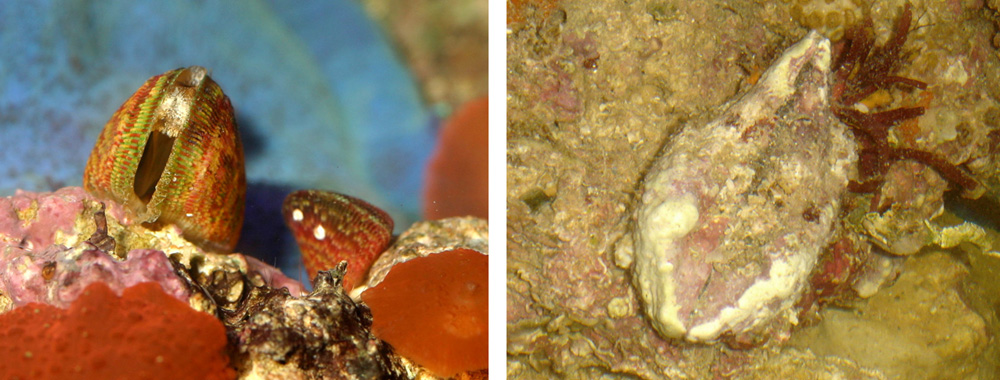
Arc clams (Arca spp.) like these are also found on aquacultured live rock at times. I cannot identify the two small ones on the left to the species level, but the one on the right is the common turkey wing clam, A. zebra, encrusted with coralline algae.
As long as a tridacnid clam gets plenty of light, these algae being maintained within its body can make more food then they need for themselves and can donate the excess to the clam host. So, a tridacnid clam doesn’t have to rely on filter-feeding when kept under optimal conditions.10 However, azooxanthellate clams aren’t so lucky, as they depend entirely on what they can strain from the water with their gills. That might not sound like too big of a problem, except that the plankton they need is typically in very short supply in aquariums. In fact, there may be essentially none present, even in a well-stocked and established reef aquarium. That means if you don’t provide am azooxanthellate clam with a steady supply of food yourself, it is very likely to slowly starve to death. And that’s exactly what usually happens.
Of course, there are several types of preserved and live phytoplankton products available these days, which can be used to feed a clam. But, as I said, clams have a surprising demand for food. So, even if you try using such a product, you’d need to give a clam a steady supply in order to keep it healthy. I’ve tried this myself over the years with a few different types of clams and a few different products, and all I can say is that even when using the best stuff on a daily basis, the clams still ended up dead (with a scant few exceptions that I’ll get to momentarily). This can take as little as a few weeks or as long as a few months, but the end result is the same – a failure to keep azooxanthellate clams alive long-term. This has been the case in smaller aquariums with few inhabitants and in larger heavily-stocked aquariums, too. I don’t recall ever talking to anyone that has done any better either, although I have to assume that someone out there has gotten lucky enough to do so.
Again, note that it can take up to several months for a clam to starve, which can often leave uninformed aquarists frustrated and scratching their heads. The reason why is that an azooxanthellate clam can look absolutely fine for months in an aquarium and the “suddenly” die for no apparent reason. But the fact is, the clam was probably slowly starving all along.
With all that said, now I want to go into a little more detail about one particular type of clam, and also say a bit about some exceptions that I’ve seen. Dr. Rob Toonen put together an excellent article about flame scallops (Lima spp.)11, which are the most commonly offered azooxanthellate clams out there, and I want to relay some of the info to you. These clams are certainly colorful and cool looking because they have long sensory tentacles that protrude from their shells, but despite their attractiveness, there are actually three reasons to resist buying one.
First of all, they’re very likely to starve over a period of weeks to months. We’ve been over that though, so I’ll move on to the other two reasons. Flame scallops also tend to hide when introduced to aquariums, which ends up being very frustrating. When placed in an aquarium containing live rock, these clams will usually scoot around by rapidly opening and closing their valves until they find some out of sight spot, and will stay there. You might be able to find one after it hides and move it back into view in what looks like a good spot, but it’ll very likely end up hiding again. Oftentimes, they’ll do this over and over until you give up. So, even though they look neat, chances are you won’t get to see much of one once it’s in your tank, unless you have a relatively barren aquarium.

Here you can see a number of thin byssal threads produced by these flame scallops as a means of attaching to the substrate. These should be carefully cut if you ever have to move one of these clams, or any other byssus-producing clam that is utilizing them.
Also note that if one sits in one place long enough, it can attach itself to anything solid. Many other sorts of clams can do the same thing, including tridacnids, via the production of byssal threads. These tough proteinaceous strands are produced by a specialized organ (the byssal organ), and they’re sort of like spider’s silk, as they’re produced in a liquid form that hardens quickly and can stick to bits of gravel, rubble, or solid substrates. Thus, they can be used by these byssus-producing clams to stay put, making an attached clam more difficult to move. Oftentimes trying to simply pull a clam away from something it’s byssally attached to can also damage the clam’s byssal organ and associated tissues, sometimes having serious or even fatal consequences. So, you really shouldn’t try pulling one off a rock, etc. if it’s firmly attached. However, it is possible to carefully cut the threads at their distal end with a razor if you need to, as the clam can discard any damaged ones and produce more when it becomes re-situated.
Lastly, there’s their natural lifespan. It’s only five years or so in their natural habitat, and that’s from the time they’re larvae to the time they die. So, if you happen to find a nice big one, it’s very likely to already be a few years old, and getting close to its time to expire. This means that even if you have great water quality, can feed one regularly with an appropriate food, and don’t mind it hiding all the time, it’s still likely to die within a few months, or maybe a year or two at best. All the more reason to leave them where they belong – in the sea.
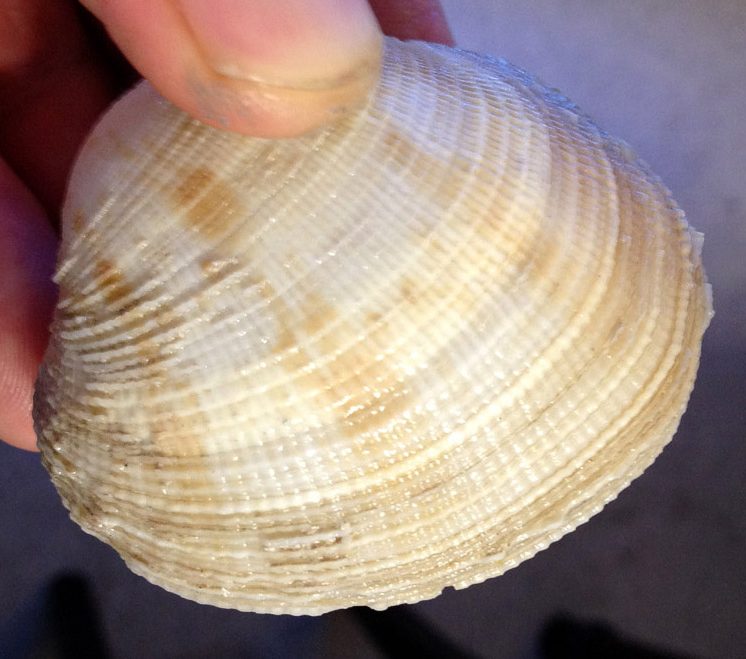
Much to my surprise, I found this good-size infaunal clam buried in the substrate of one of my aquariums, but I didn’t put it there…
What about those exceptions I mentioned? Well, for whatever reason, over the years I’ve had a few jewel box clams and turkey wing clams (both pictured above) that did very well. I didn’t buy them as individual specimens though, as they showed up regularly on live rock from Florida waters. I’m not sure how they stayed alive, but I have to assume that these clams in particular weren’t as picky about what they ate and could cover their dietary needs with whatever was found in good supply in my aquariums. I’m assuming they could make good use of detritus/bacteria and relied less on plankton, but that’s just speculation on my part. Regardless, these clams often lived for years without any troubles. So, if for some reason you’re just dying to try an azooxanthellate clam in your aquarium, I suggest trying small specimens of either of these.
Lastly, I have on one occasion had an infaunal clam seemingly appear out of nowhere. While cleaning the sand bed in my 125 gallon mixed reef aquarium one day, I managed to accidentally find the clam pictured below. I did not add this one to the aquarium though, so I’m not sure how it got there. It was alive, so I put it back where I found it and have never seen it again (although I haven’t tried to find it, either). I never add planktonic foods to this aquarium, so again, I’m going to assume that this unidentified clam can make good use of detritus/bacteria. It might be worth noting that the aquarium has a deep sand bed, is heavily stocked, and is run without a skimmer, too. It seems there are always exceptions to general rules.
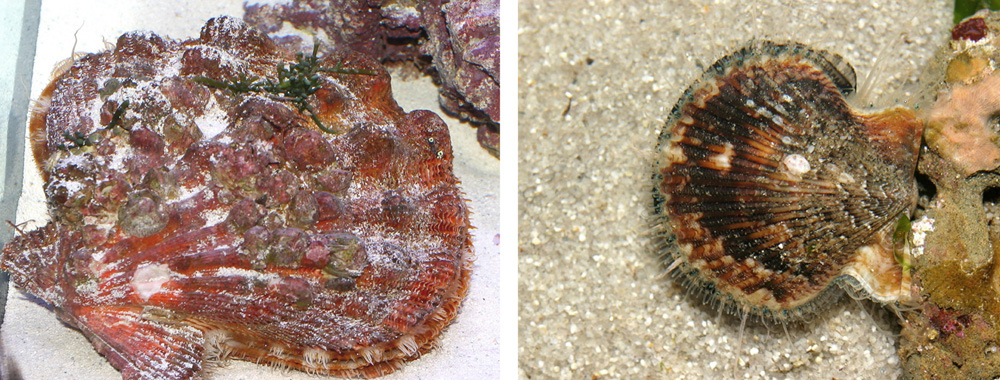
On the left is a knotty scallop (Lyropecten nodosus), one of the more commonly-seen clams for sale. On the right is a common scallop (probably Chlamys sp.), which is byssally attached to a rock.
And, that’s about it. One last time I say, the vast majority of azooxanthellate clams do not survive long term in aquariums, unless perhaps you give them a steady supply of an appropriate food. So, they should be avoided and left in their natural habitat unless you’re ready to do whatever it takes to keep them alive.
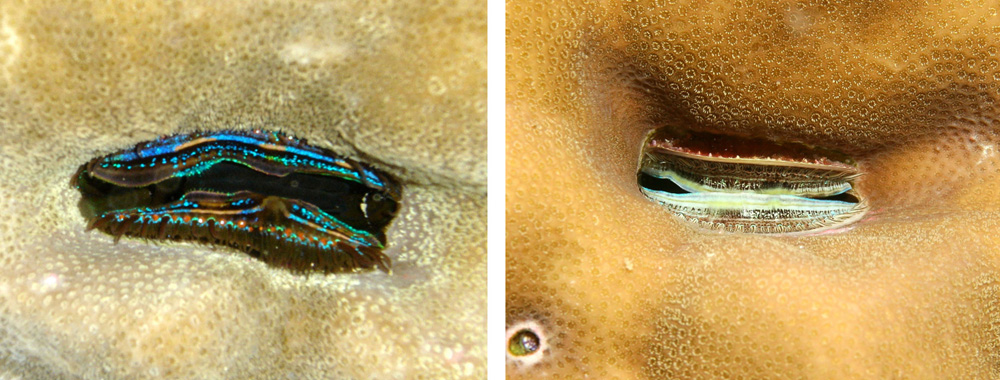
These are coral clams (Pedum spongyloideum), which are often called iridescent scallops when brightly colored. These clams spend their lives embedded in various corals, usually Porites spp.
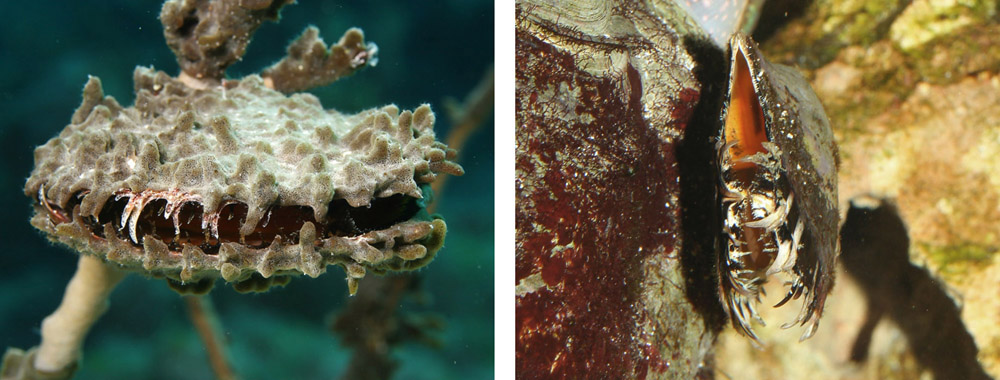
On the left is the Atlantic Wing Oyster, Pteria colymbus, which is commonly found byssally attached to the stalks/branches of gorgonians. This one is covered by living sponge, which is also common for this and many other types of epifaunal clam. On the right is a very small specimen of the same species (I believe) that I collected myself. I tried to keep it in one of my big reef aquariums, where it attached itself to the side of a tridacnid’s shell, but it died within a month’s time.
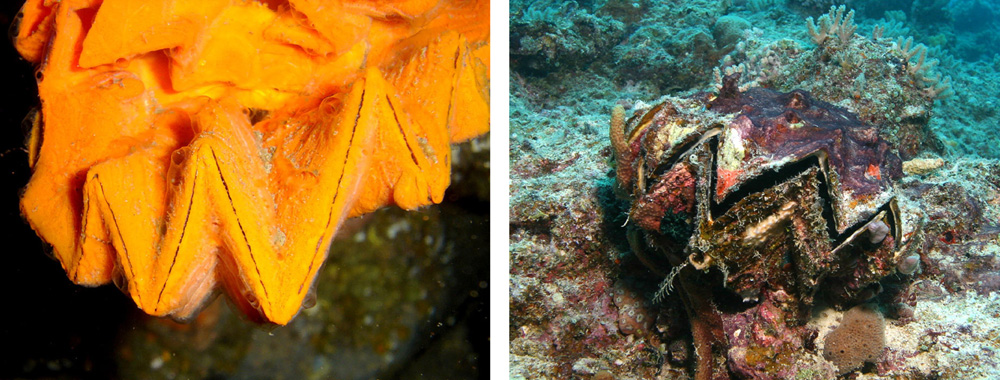
Cock’s comb oysters, Lopha spp. and Pycnodonta spp., like these show up in stores from time to time. While the specimen on the left appears to be bright orange, they really aren’t colorful at all. This one is covered by an orange sponge, and sponges are typically difficult to maintain long-term, too. So, both are likely to starve in an aquarium.

These are rock oysters, probably Saccostrea sp. or Alectryonella sp. Many oysters live on hard substrates upon which they can fuse their shells as they produce new shell material.
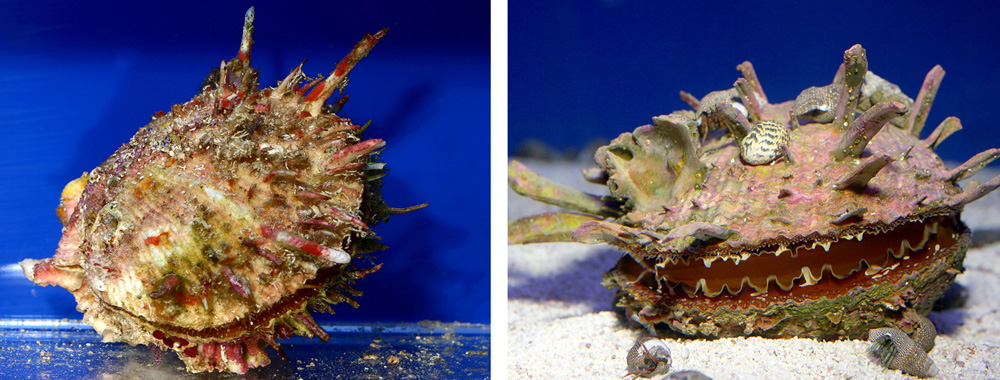
These are spiny/thorny oysters, Spondylus spp., which are also commonly-offered azooxanthellate clams.

These are variable spiny oysters, Spondylus varius, which are also typically fused to hard substrates.
References
- Fankboner, P.V. 1981. Siphonal eyes of giant clams (Bivalvia:Tridacnidae) and their relation to adjacent zooxanthellae. Veliger 23:245-249.
- Land, M.F. 2003. The spatial resolution of the pinhole eyes of giant clams (Tridacna maxima). Proceedings of the Royal Society of London Biological Science 270:185-188.
- Rupert, E.E., R.S. Fox, and R.D. Barnes. 2004. Invertebrate Zoology: A Functional Evolutionary Approach: 7th ed. Brooks, Cole, Thomson, Belmont, CA. 963pp
- Langdon C.J. and R.I.E. Newell. 1990. Utilization of detritus and bacteria as food sources by 2 bivalve suspension-feeders, the oyster Crassostrea virginica and the mussel Geukensia demissa. Marine Ecology Progress Series58:299-310.
- Kreeger, D.A. and R.I.E. Newell. 1996. Ingestion and assimilation of carbon from cellulolytic bacteria and heterotrophic flagellates by the mussels Geukensia demissa and Mytilus edulis (Bivalvia, Mollusca). Aquatic Microbial Ecology 11:205-214.
- Tamburri, M.N. and R.K. Zimmer-Faust. 1996. Suspension feeding: Basic mechanisms controlling recognition and ingestion of larvae. Limnology and Oceanography 41(6):1188-1197.
- Lehane, C. and J. Davenport. 2002. Ingestion of mesoplankton by three species of bivalve; Mytilus edulis, Cerastoderma edule, and Aequipecten opercularis. Journal of the Marine Biological Association U.K. 82:615-619.
- Wong, W.H., J.S. Levington, B.S. Twining, N.S. Fisher, K.P. Brendan, and A.K. Alt. 2003. Carbon assimilation from rotifer Branchionus plicatilis by mussels, Mytilus edulis and Perna viridis: a potential food web link between zooplankton and benthic suspension feeders in the marine system. Marine Ecology Progress Series 253:175-182.
- Wong, W.H. and J.S. Levinton. 2004. Culture of the blue mussel Mytilus edulis (Linnaeus, 1758) fed both phytoplankton and zooplankton: a microcosm experiment. Aquaculture Research 35:965-969.
- Fatherree, J.W. 2006. Giant Clams in the Sea and the Aquarium. Liquid Medium. Tampa, FL. 227pp.
- Toonen, R. 2002. Flame Scallops. Advanced Aquarist’s Online Magazine, 1(7). URL: http://advancedaquarist.com/issues/july2002/toonen.htm


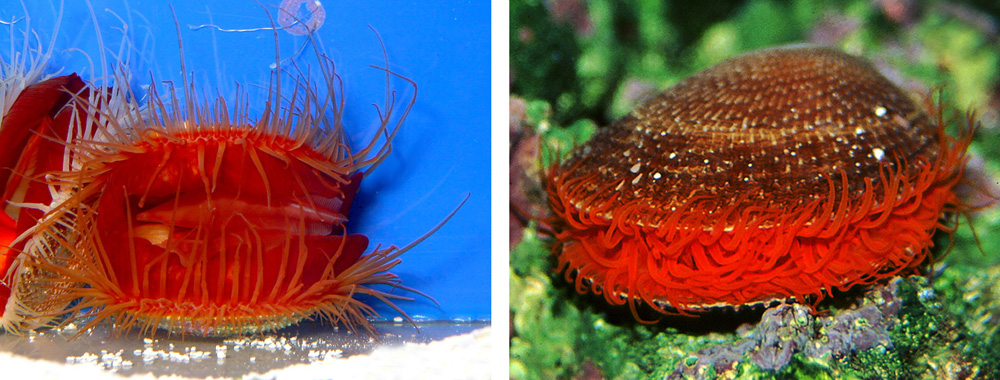

0 Comments